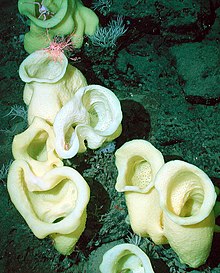Lyssacinosida
| Lyssacinosida | ||||||||
|---|---|---|---|---|---|---|---|---|

Watering can sponge ( Euplectella aspergillum ) |
||||||||
| Systematics | ||||||||
|
||||||||
| Scientific name | ||||||||
| Lyssacinosida | ||||||||
| Zittel , 1877 |
Lyssacinosida is an order in the class of the glass sponges (Hexactinellida) in the trunk of the sponges (Porifera).
features
The order belongs to the subclass Hexasterophora, the members of which can be recognized by the morphology of the skeletal needles or spicules, which, as with all glass sponges, consist of biogenic opal ( amorphous silicon dioxide ). These are divided into the larger needles or megasclera (typically about 0.2 to 30 millimeters long) and the smaller microsclera embedded in the soft body (length less than 0.1 millimeter). The microslera of the Hexasterophora, the so-called Hexasterene, are six-pointed, star-like formations from within the various families and species of great abundance of forms. The "classic" Lyssacinosida, the three families Euplectellidae, Leucopsacidae and Rosellidae are characterized by the fact that their larger skeletal needles or megasclera, located in the spongy body apart from the inner and outer surface layers, are predominantly single and unconnected. More recent research, which also takes phylogenomic data into account, in which the relationship is determined by comparing homologous DNA sequences, has shown, however, that the lyssacinosida understood in this way do not form a monophyletic unit. The family Aulocalycidae, which was previously listed in a separate order Aulocalycoida, has to be added to the classic three families. The Aulocalycidae are among the glass sponges in which the megasclera form a solid, fused skeleton.
Lyssacinosida are typically white, oval, cup-shaped or tubular sponges with a soft body and a single, terminal osculum, which are typically perched on a hard substrate of the seabed . On the side of the water inflow there is usually a large, sunken cavity, the atrium. Branched tubes or fan-like formations or tongue-like plates without a clearly recognizable atrium and with several oscula are also less common. In the case of thin-walled forms, the osculum can be protected by a sieve plate. They sit on the seabed either directly or by means of a short stalk, up to an elongated stalk. The anchoring on the substrate can take place in two ways: Either they form a sieve-like plate made of fused skeletal needles that cement the animal to the ground ("basiphytic"), or they anchor themselves through tuft-like, longer needles ("lophophytic"). Mostly relatively small, individual species, especially on the seabed of the Antarctic Sea, such as the "volcanic sponge" Anoxycalyx joubini (family Rossellidae) can reach heights of two meters and widths of over one meter, so that supposedly a diver can hide inside . Typically, however, the shapes with unconnected skeletal needles remain smaller than those with a connected skeleton.
Biology and ecology
Like all glass sponges, the Lyssacinosida prefer to colonize the seabed of the deep sea at depths greater than 500 meters. They occur mostly sporadically around the world, but also form dense aggregations less often.
Systematics
In the current definition, the order contains four families plus some genera of unclear affiliation ( incertae sedis )
- Family Aulocalycidae Ijima , 1927
- Family Euplectellidae Gray , 1867
- Family Leucopsacidae Ijima , 1903
- Family Rossellidae Schulze , 1885
The families Alcyoncellidae, Caulophacidae, Placoplegmidae and Sympagellidae, which were previously differentiated, are no longer recognized taxonomically today. The order was first established by Karl Alfred von Zittel in 1877 under the name Lyssakina. Further synonyms are Euplectallaria Schrammen, 1903, Lyssacina Ijima, 1903, Lyssacinaria Schrammen, 1924, Lyssacinosa Ijima, 1927.
Individual evidence
- ↑ a b Henry M. Reiswig: Order lyssacinosida Zittel, 1877 In: Systema Porifera: A Guide to the Classification of Sponges. , Edited by John NA Hooper and Rob WM Van Soest, Kluwer Academic / Plenum Publishers, New York, 2002.
- ↑ a b Martin Dohrmann, Christopher Kelley, Michelle Kelly, Andrzej Pisera, John NA Hooper, Henry M. Reiswig (2017): An integrative systematic framework helps to reconstruct skeletal evolution of glass sponges (Porifera, Hexactinellida). In: Frontiers in Zoology 14: 18 doi : 10.1186 / s12983-017-0191-3
- ↑ Bruno Danis: A Field Guide to Antarctic Sponges. The SCAR Antarctic Field Guides. World Wide Web publication, download
- ^ Van Soest, R. (2009). Lyssacinosida. In: Van Soest, RWM; Boury-Esnault, N .; Hooper, JNA; Rützler, K .; de Voogd, NJ; Alvarez de Glasby, B .; Hajdu, E .; Pisera, AB; Manconi, R .; Schoenberg, C .; Klautau, M .; Picton, B .; Kelly, M .; Vacelet, J .; Dohrmann, M .; Díaz, M.-C .; Cárdenas, P .; Carballo, JL (2017). World Porifera database. Accessed through WoRMS World Register of Marine Species, accessed May 2, 2017.
Web links
- Lyssacinosida on marinespecies.org

